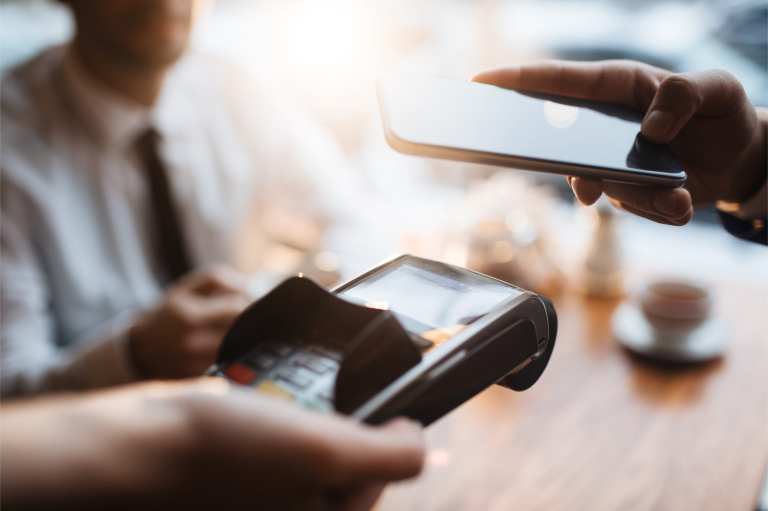
The partial shutdown of the U.S. retail economy is unprecedented. Terror attacks on 9/11 happened well before the internet was a factor, and are therefore not relevant as a comparison. And other public health crises like flu epidemics didn’t come close to the current need for social distancing. So what sticks? What are some of the retailing changes that could last beyond the end of the coronavirus crisis?
The smart money at this point is on three factors: contactless payments, locally-sourced food and remote service delivery. Two other factors have been downplayed for the purpose of this analysis. One is eCommerce, which had already been on the rise after a jump during the holiday season and will most likely not see a permanent percentage jump after stores are open full-time. The other is home delivery, as it too was becoming a consistent factor before the crisis.
Contactless payments, however, will fit nicely into what will be a need to have low-touch or no-touch retailing experiences. Pre-crisis contactless had been slated for $83 million in revenue this year.
“Retail customers want contactless payment technology because of coronavirus,” writes RCR Wireless columnist Jeff Kagan. “Suddenly, this issue is front and center for every retailer and every customer. Today, cornonavirus or COVID-19 gives us even more reason to move toward touchless technology to keep all of us safe and healthy. The problem is most retailers don’t seem to understand what their customers want. They want to be safe and stay healthy. They want convenience. They want contactless payment technology. That means they don’t want to touch a keypad or screen or pen. So, every retailer must solve this growing area of customer concern or they will lose out on sales and business because going forward, customers will be much more careful than ever before.”
Along the lines of the contactless trend, expect remote services such as telehealth and eLearning to spike on a year-to-year basis after the crisis is over. For example, a “care automation” startup out of Seattle, Bright MD, has extended its guided questionnaire diagnostic approach to COVID-19 to hospitals and physician groups. It’s a necessary step at this time, but also an example of the telehealth value prop, according to CEO Ray Costantini.
“We are wired as a species to watch out for the tiger in the grass,” he says. “And I think part of our job as responsible stewards of the healthcare industry is to help patients understand the need to have real facts and insights that can help them make better choices and navigate the complicated process that is, healthcare, even in scary times.”
On the eLearning side, school districts all across the country have had to press tentative eLearning strategies into action. Before the pandemic, eLearning had been clicking along at a pace to reach $325 million by 2025. Now it will remain to be seen if eLearning spikes dramatically when the September school year starts. It also remains to be seen if new challenges will be presented.
“The COVID-19 pandemic will likely continue presenting challenges beyond those that come up in the course of routine virtual education,” according to Scientific American. “Even if this viral spread subsides, or a vaccination becomes readily available, the shift from online classes back to in-person learning may create disruptions of its own — adjusting back to higher standards of accountability, weaning off of phone-checking habits, and transferring comments back to hard copies instead of digital notes. Hopefully, these phases of trouble shooting can provide universities, professors and students the opportunity to practice adaptability, patience and resilience. And hopefully, these experiences will serve as preparation for future challenges that come with the next epidemic, pandemic and other disasters.”
Finally, consumers will want to know where their food comes from. This had been trending with the move toward organic food. But sourcing will be essential. The “farm to table” movement will need to be documented. Nielsen has been studying the phenomenon, which has taken on a new urgency.
“This represents an opportunity for retailers and manufacturers that can leverage local’s appeal to mitigate consumer concerns,” says Nielsen. “Shoppers are exhibiting signs that they may steer away from products that travelled long distances with multiple human touchpoints, particularly products such as dairy, fruit, vegetables and meats. And that means that products that come off factory lines or rely on distribution systems from some of the hardest hit countries could face challenges, and multinational brands will need to work to maintain consumer confidence.”
What else will change from crisis reaction to consistent behavioral change? “Many sectors will reemerge to new market realities in China and elsewhere,” according to Harvard Business Review. “Indeed, the SARS crisis is often credited with accelerating the adoption of e-commerce in China. It is too early to say for sure which new habits will stick in the long run, but some strong possibilities include a leap from offline to online education, a transformation in health care delivery, and an increase in B2B digital channels.”